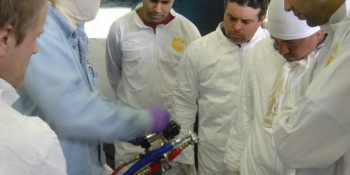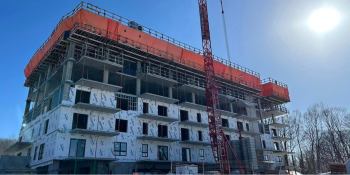Q&A Forums
Foam separating from studs Post New Topic | Post Reply
| Author | Comments |
|---|---|
|
Dan White
Posted: May 03, 2009 08:58 PM
|
Foam separating from studs
Hi. One more concern with my recent closed cell insulation job (I'm the homeowner). There is one corner of the house, about 30' along one wall and 15' along the adjoining one where there are gaps between the foam and the studs. This doesn't happen on every stud, but on maybe a quarter. Some of the gaps are small, like under 1/4", but others are 1/2 to maybe even a full 1" wide. I think it was very cold the day that section was sprayed. There is no other problem like this in the rest of the house. Anyway, the sprayer came back and filled the void areas with a can foam. Just today I saw more gaps that he missed and I don't know if the foam shrank since he last fixed it, or if he just missed some of the gaps. The foam that has gaps still feels very stiff and attached to the exterior wall, but I can't know for sure. Anyway, I filled some gaps with the Dow canned foam you find at Home Depot. I used a whole can and still have more gaps to fill. One more can will most certaintly finish the gaps.The question I have is whether this Dow foam will provide the air flow barrier and insulation that I need, or am I trying to fix a bad job that can't be fixed? The foam insulating guy has to come back to finish some attic work. Should I ask him to rip this out and redo it, or will the Dow filled cracks be OK? The sheetrockers are going to cover this section up Monday morning, so I am hoping for some quick feedback so I can hold them off if necessary. Thanks! |
|
mason
Posted: May 04, 2009 09:10 AM
|
The canned foam at the hardware store does not have the same physical properties as the closed cell foam. Your contractor should remove the foam that has cracked or shrunk at a 45 degree angle until you get to foam that is stuck well, then spray foam in 1/2 inch to 1 inch thick lifts until the desired thickness is achieved. Make sure they wait between passes for the exothermic heat to dissipate. (usually about 10 minutes) |
|
Dan White
Posted: May 04, 2009 11:08 PM
|
Thanks. I was hoping you'd say the Dow foam would at least block airflow if not insulate as well as the spray foam. It looks like I'll have to live with it since it was sheetrocked today. The timing wasn't good as my foam contractor is not close to me. Anyway, the total area of shrinkage is small compared to rest of the wall, which appears to be well insulated. I was just concerned that the foam doesn't continue to shrink. It has been about 2 weeks since it was originally sprayed so I'm hoping it won't move anymore. |
|
mason
Posted: May 06, 2009 08:46 PM
|
You will want to check in a few months. An infra red scan may be able to determine if any foam has shrunk |
|
Dan White
Posted: May 06, 2009 10:26 PM
|
Thank you. They are planning on doing a scan and a blower test after sheetrocking is complete. I'll mention about coming back later in the year to do another scan. |
|
Thomas Barbato
Posted: May 07, 2009 07:05 AM
|
Do you know what brand of closed cell foam they used??? I've learned recently that all cc foam will pull away from the studs if the moisture content in the wood is not less than 17 to 18%. i'm not stating this as a fact but based on my experiences installing different cc foams it seems realistic. |
|
Dan White
Posted: May 07, 2009 07:45 AM
|
All I know is that it is a BioBased insulation. I have a small green brochure saying that it has soy in it. It is a pale tan/yellow color like the Dow foam in a can. I can find out the exact name. |
|
richard sucher II
Posted: May 08, 2009 08:07 AM
|
Where to start. Have you paid the applicator yet? Would consider holding payment until this is resolved to your satisfaction. Agri based foam are problematic at low temps application wise - experienced applicator would recognize this and adjust accordingly. Personally, we have used caution when embracing the soy based materials for the very reasons that you describe. We have found more proven results are achieved with the "sugar based" foam systems. Even then, these systems can be very tricky, especially at colder temps. Moisture in studs,substrate temps, use of non vented heat source within space, temperature and/or mixing of foam material - all require applicator that knows what he is doing. How experienced was this company? This applicator? Many of the soy based foamers are new to the game and do not have the experience to recognize that this problem will occur. Good chance that this shrinkage was taking place as the walls were being done and would have been visible during the application stage. given the conditions you describe, applicator should have sprayed a cavity and then waited to see how the foam was reacting. shrinkage occurs rather rapidly. As far as the repair is concerned, would have been nice if applicator would have used two component foam kit to make repairs. sounds like 100 or 200 board foot kit would have done the trick. same physical properties - just more expensive. I feel your pain - paid for airtight system and you are not sure that you got it. |
|
Dan White
Posted: May 08, 2009 03:38 PM
|
I'm still holding a significant amount of $, as agreed with the applicator. My concern is whether the foam will continue to shrink. I think it was Mason who said to recheck it in several months. For the record, all the rest of the house (well, nearly all) has a thick layer of cc foam and shrinkage does not appear to be an issue. It is just this secton of the main floor that was done during cold weather. They said they will do an IR camera on it, but what does this tell you if there is no heat/cold in the house and it is spring temps outside? Will the IR really tell you anything, and will shrinkage occur in the coming months? Thanks again for all the replies! |





























